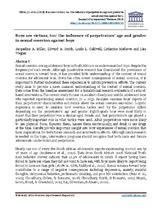Boys are victims, too: the influence of perpetrators’ age and gender in sexual coercion against boys
Date
2018Author
Miller, Jacqueline A.
Smith, Edward A.
Caldwell, Linda L.
Mathews, Catherine
Wegner, Lisa
Metadata
Show full item recordAbstract
Sexual coercion among adolescent boys in South Africa is an underresearched topic despite the frequency of such events. Although quantitative research has illuminated the prevalence of sexual coercion toward boys, it has provided little understanding of the context of sexual coercion for adolescent boys. Given the often severe consequences of sexual coercion, it is important to further understand these experiences to inform prevention efforts. The current study aims to provide a more nuanced understanding of the context of sexual coercion. Data come from the baseline assessment for a translational research evaluation of a school-based intervention. The current study focuses on a subset of early and middle adolescent boys who reported experiencing sexual coercion (n = 223). Analyses examine boys’ reports of their perpetrators’ characteristics and details about the sexual coercion encounter. Logistic regression is used to examine how coercion tactics used by the perpetrator differs depending on the perpetrator’s age and gender. Eighth-grade boys were most likely to report that their perpetrator was a similar-aged female and that perpetrator’s age played a particularly important role in what tactics were used. Adult perpetrators were more likely to use physical force, threaten them, harass them electronically, and drink or use drugs at the time. Results provide important insight into boys’ experiences of sexual coercion that have implications for both future research and intervention efforts. Although much research is needed on the topic, intervention programs should recognize that both male and female adolescents can be victim and perpetrator.

